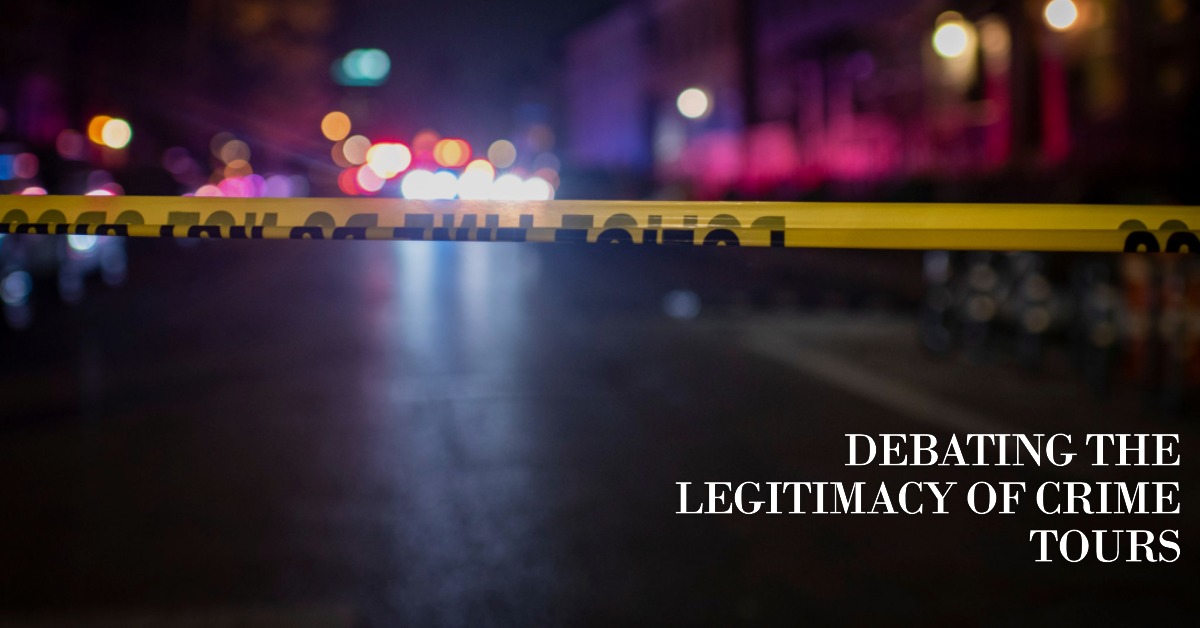Crime tours have long been a source of fascination for tourists and locals alike, offering them the opportunity to delve into the darker side of history. These guided excursions explore notorious crime scenes, recount ghostly tales, and provide juicy gossip about infamous criminals that we just can’t seem to get enough of.
But as these twisted journeys continue to gain popularity, it’s time we asked ourselves: are crime tours glorifying lawlessness or merely satisfying our innate curiosity about the macabre?
In this article, we’ll examine both sides of the debate surrounding the legitimacy of crime tours. We’ll hear from those who argue that such experiences trivialize human suffering and normalize violence by turning tragedy into entertainment.
On the other hand, we’ll also present perspectives from tour operators and satisfied participants who believe that these outings serve an important educational purpose – shedding light on historical events while sparking valuable conversations about criminal justice systems past and present.
So buckle up as we embark on a controversial journey through dark corners teeming with unsettling truths and ethical dilemmas at every turn.
The Appeal Of Dark Tourism
Dark tourism motivations are complex and multifaceted, with a growing number of individuals becoming increasingly drawn to the macabre. Crime fascination, in particular, has led tourists to seek out destinations that have been touched by tragedy or criminal acts.
Whether it’s visiting the infamous murder sites of Jack the Ripper or retracing the steps of notorious gangsters like Al Capone, these crime tours provide an immersive experience for those who wish to delve into humanity’s darker side.
While some may argue that this interest in criminal history is simply a morbid curiosity, others contend that engaging with such grim subject matter can foster empathy and understanding towards victims and their families. Moreover, exploring these tragic events allows us to confront our own fears and mortality while providing valuable insight into cultural differences as well as historical context.
As we navigate through this murky territory, it is crucial to examine both sides of the debate surrounding the legitimacy of crime tours before forming any definitive opinions on their merit or ethical implications.
Arguments Against Crime Tours
Arguments against crime tours often center around the idea that these experiences can inadvertently glorify criminals and exploit their victims. Critics argue that by highlighting the notorious deeds of infamous lawbreakers, tour operators are capitalizing on human tragedy for profit. The exploitative nature of such ventures becomes apparent when considering:
- Participants pay to hear grisly details about horrific events, turning personal tragedies into entertainment.
- Tours may feature graphic depictions or reenactments of crimes which could perpetuate fear and trauma for surviving family members.
- Glorifying criminals can lead to copycat behavior and encourage a morbid fascination with lawlessness.
- By focusing on sensationalized stories, crime tours may overshadow more constructive conversations about criminal justice reform.
Despite these concerns, proponents maintain that there is value in examining the darker aspects of society through educational perspectives and benefits.
Educational Perspectives And Benefits
A staggering 42% of adults in the United States admit to having a fascination with true crime, according to a recent study.
This appetite for sordid details and gruesome stories has paved the way for an unusual learning opportunity: crime tours. These guided excursions are designed to provide participants with a deeper understanding of infamous criminal cases by tracing their histories and visiting relevant locations associated with these events.
Crime education, when presented through this unique medium, allows people to gain insights into the psychological, social, and historical aspects of notorious crimes that may not be accessible through traditional means such as books or documentaries.
Moreover, exploring these dark narratives within their real-life settings can foster empathy towards victims and deepen our comprehension of how such tragedies unfolded. However, it is essential to assess whether this unconventional method of imparting knowledge comes at too high a cost – which leads us to examine ethical considerations surrounding crime tours further down the line.
Ethical Considerations
This delicate balance between education and entertainment raises important questions about the moral boundaries of crime tours.
As we delve deeper into this controversial attraction, it becomes essential to confront the ethical dilemmas surrounding these excursions.
Exploring such ethical quandaries is crucial in determining whether crime tours can be conducted responsibly or if they inherently exploit tragic events for profit.
We must now examine responsible crime tour practices that may offer a solution to these concerns and help establish guidelines for future operators.
Responsible Crime Tour Practices
It is evident that crime tours walk a fine line between education and exploitation, making it imperative for tour operators to follow responsible practices. In light of the ongoing debates surrounding their legitimacy, some steps have been taken towards crime tour regulation with an aim to mitigate community impact and ensure ethical conduct. However, further measures are necessary in order to strike a balance that satisfies all parties involved.
To this end, we propose the following guidelines for responsible crime tour practices:
- Accuracy and Context: Providing accurate information about the crimes showcased on the tour, as well as placing them within their historical and social contexts, minimizes sensationalism while promoting informed discussions.
- Respect for Victims and Their Families: Ensuring sensitivity towards those directly affected by the crimes discussed is essential; this may involve avoiding graphic descriptions or images, consulting with victims’ families before including certain stories in the tour, or even offering support through donations to relevant causes.
- Community Engagement: Fostering communication with local communities can help address concerns about potential negative impacts of these tours (e.g., increased criminal activity) and identify ways to promote positive outcomes (e.g., raising awareness about public safety issues).
- Ongoing Evaluation: Regularly assessing the content, presentation style, and overall effectiveness of crime tours will enable providers to refine their offerings in response to feedback from participants and other stakeholders.
By adhering to such principles when designing and conducting true-crime experiences, organizers might just find themselves navigating an intricate path where curiosity meets sensitivity—an essential traversal if they’re seeking not only profit but also enlightenment for their audiences.
Balancing Curiosity And Sensitivity
The debate surrounding crime tours often centers around the delicate balance of satisfying people’s curiosity while maintaining sensitivity towards the victims and their families.
Critics argue that these tours can veer into the territory of crime glorification, as they may inadvertently romanticize or trivialize heinous acts committed by notorious criminals. They contend that rather than educating visitors on the historical context or consequences of such crimes, tour operators might cater to a morbid fascination with violence and death.
However, proponents of crime tours assert that it is possible to create an experience that piques interest in true crime stories without sensationalizing them. By ensuring accurate representation of events, providing appropriate context, and addressing potential trauma for those affected by these criminal acts, tour organizers can develop more responsible offerings.
It is crucial for all stakeholders involved – from guides to tourists – to approach this contentious form of entertainment with a sense of empathy and responsibility towards those who have been directly impacted by these crimes.
Conclusion
In the end, we must ask ourselves whether our insatiable curiosity is worth potentially exploiting tragic events for entertainment.
Crime tours can be educational and enlightening, but they also run the risk of sensationalizing human suffering.
As responsible tourists and empathetic human beings, it’s crucial that we strike a delicate balance between satisfying our morbid curiosities and maintaining respect for those affected by these heinous acts.
The future of dark tourism hinges on this tightrope walk of ethics and sensitivity.

